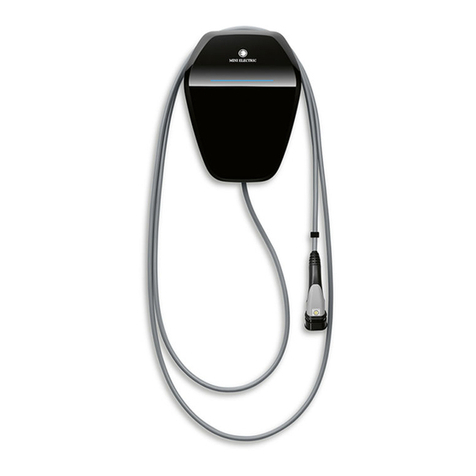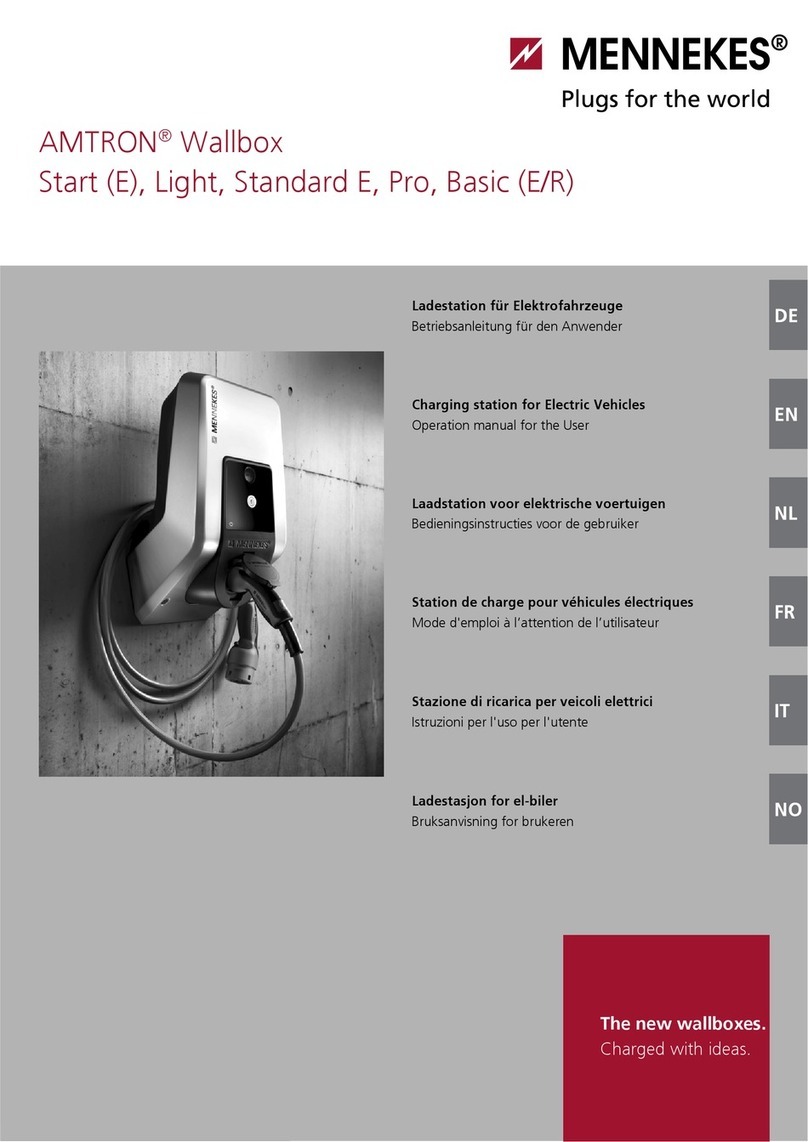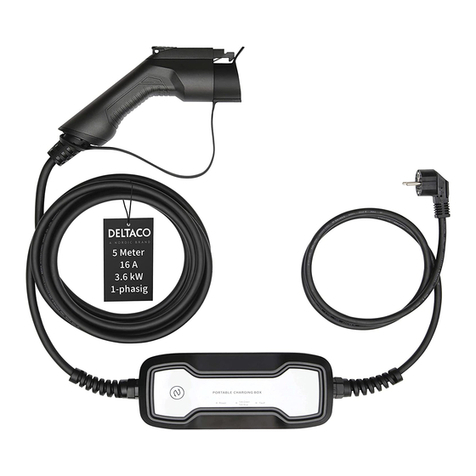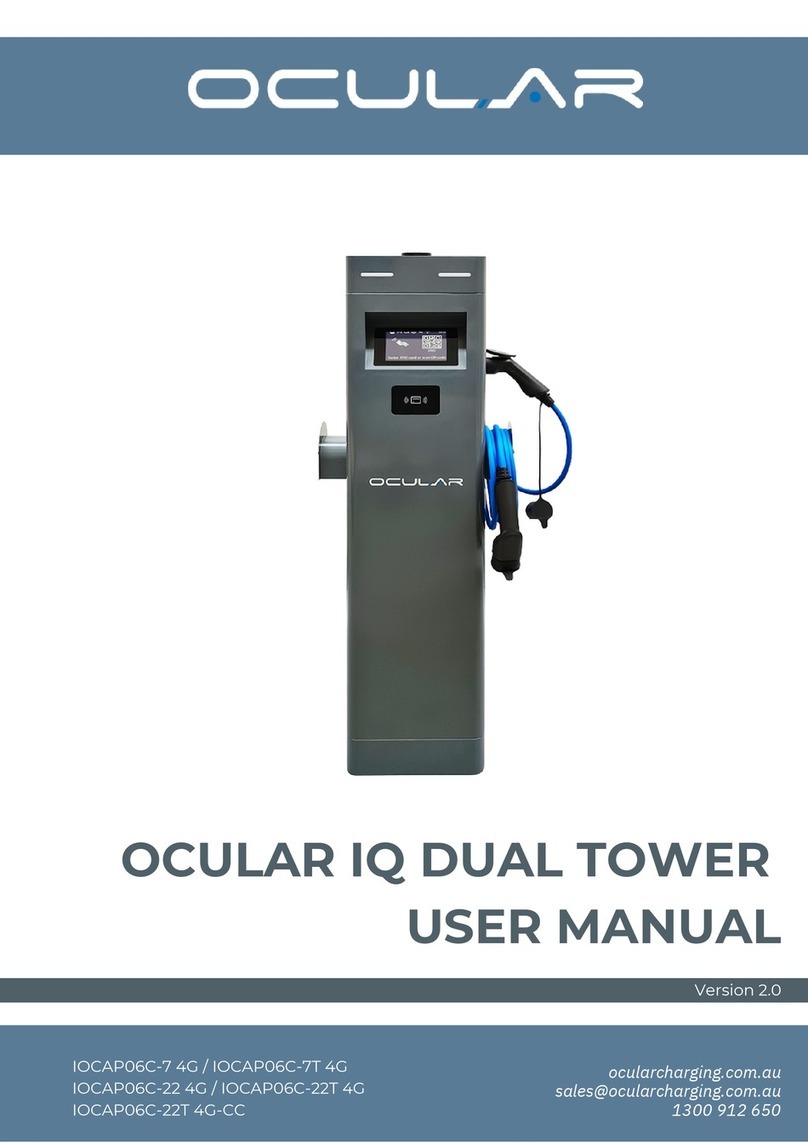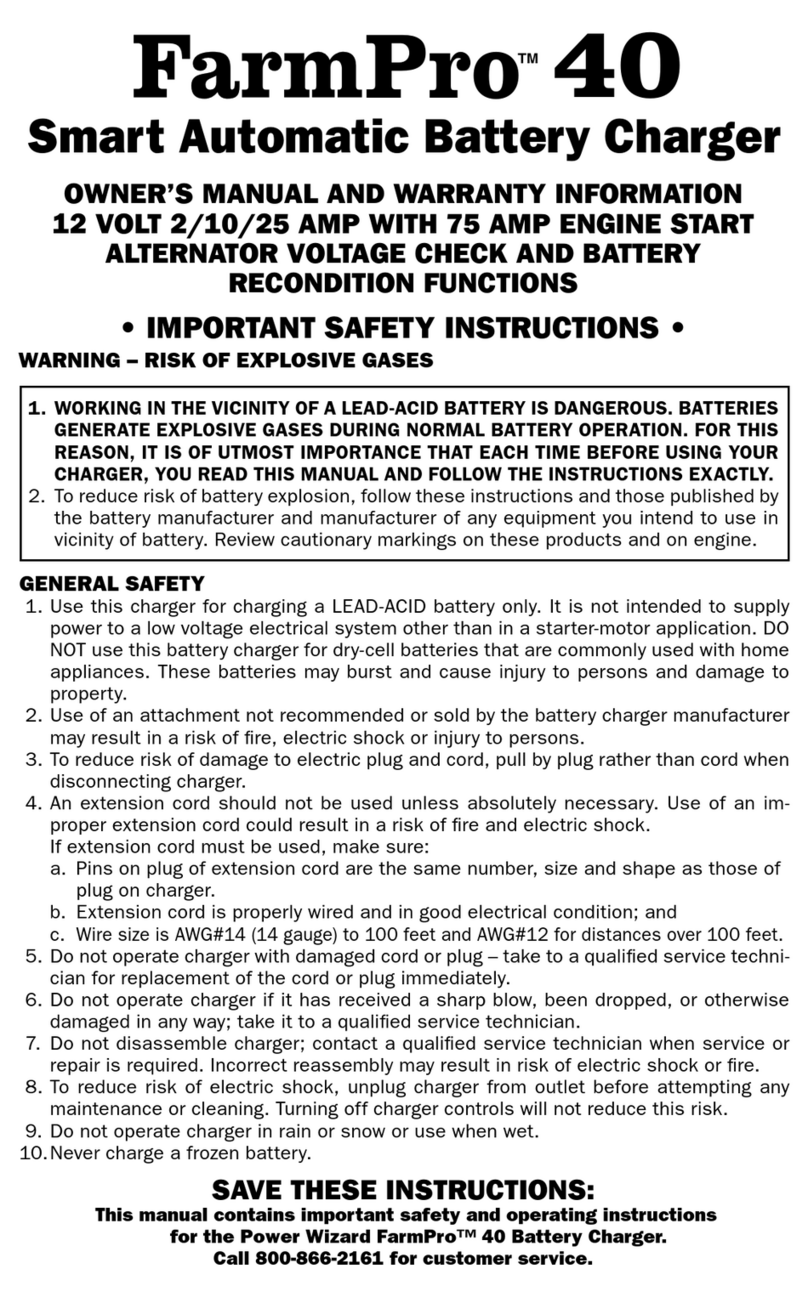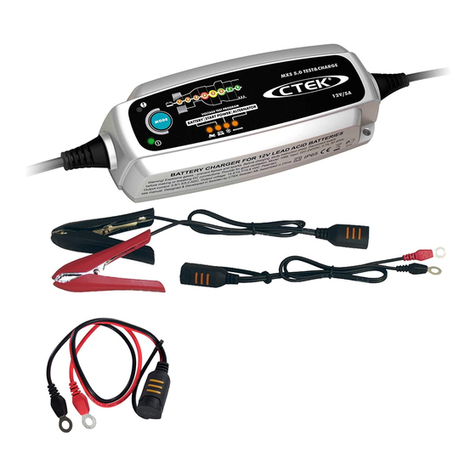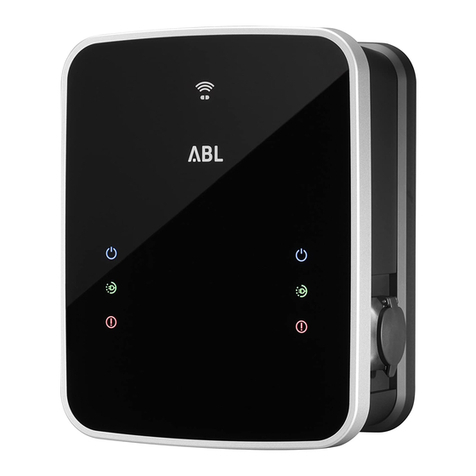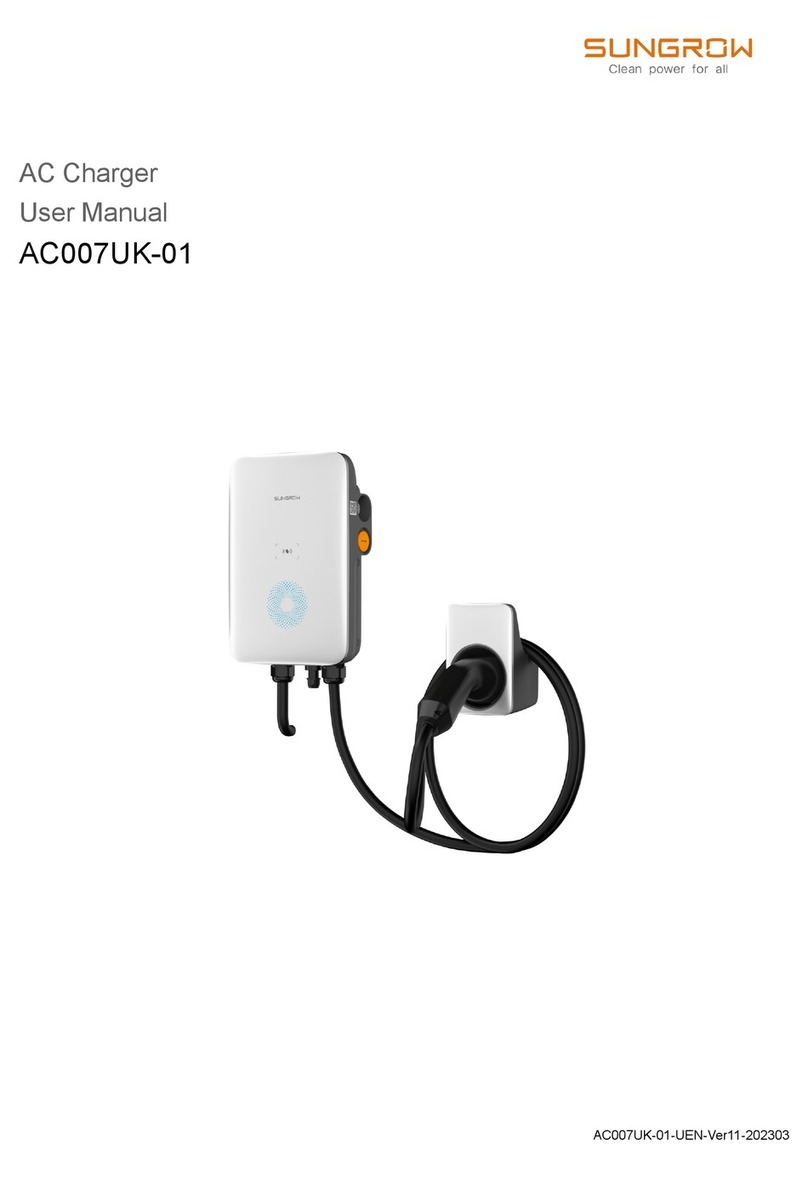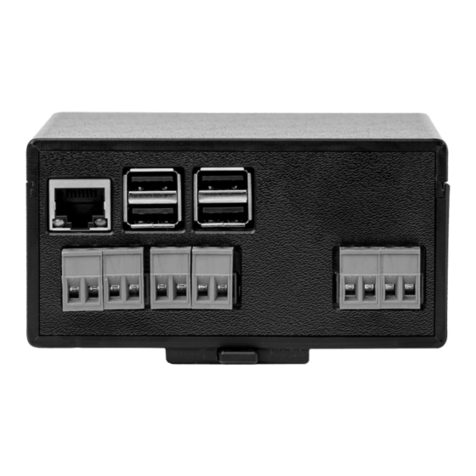Proseries PSW-2035 User manual

0099001597-00
MODEL / MODELO / MODÈLE :
PSW-2035
Manual Battery Charger
Cargador de batería manual
Chargeur de batterie manuel
OWNER’S MANUAL
MANUAL DEL USUARIO
GUIDE D’UTILISATION
PLEASE SAVE THIS OWNERS MANUAL AND READ BEFORE EACH USE.
This manual will explain how to use the battery charger safely and effectively.
Please read and follow these instructions and precautions carefully.
POR FAVOR CONSERVE ESTE MANUAL DEL USUARIO Y LEALO ANTES
DE CADA USO. En este manual le explica cómo utilizar el cargador de batería
de manera segura y conable. Por favor, lea y siga las siguientes instrucciones
y precauciones.
GARDER LE MANUEL D’INSTRUCTION ET LISEZ LE AVANT CHAQUE
UTILISATION. Ce manuel explique comment utiliser le chargeur de batterie
d’une façon securitaire et efcace. S’il vous plaît lisez et suivez ces instructions
et precautions.

•2 •
1. IMPORTANT SAFETY INSTRUCTIONS
SAVE THESE INSTRUCTIONS.
1.1 SAVE THESE INSTRUCTIONS –
This manual contains important safety
and operating instructions.
1.2 Keep out of reach of children.
1.3 Do not expose the charger to rain or snow.
1.4 Use of an attachment not recommended
or sold by Schumacher®Electric
Corporation may result in a risk of re,
electric shock or injury to persons.
1.5 To reduce the risk of damage to electric
plug and cord, pull by the plug rather than
the cord when disconnecting charger.
1.6 An extension cord should not be used
unless absolutely necessary. Use of
improper extension cord could result
in a risk of re and electric shock. If an
extension cord must be used, make sure:
• That the pins on plug of extension cord
are the same number, size and shape
as those of plug on charger.
• That extension cord is properly wired
and in good electrical condition
• That wire size is large enough for AC
ampere rating of charger as specied in
section 8.
1.7 Do not operate charger with damaged
cord or plug – replace the cord or plug
immediately.
1.8 Do not operate charger if it has received
a sharp blow, been dropped, or otherwise
damaged in any way; take it to a qualied
serviceman.
1.9 Do not disassemble charger; take it to
a qualied serviceman when service or
repair is required. Incorrect reassembly
may result in a risk of electric shock or re.
1.10 To reduce risk of electric shock, unplug
charger from outlet before attempting
any maintenance or cleaning. Turning off
controls will not reduce this risk.
1.11 WARNING: RISK OF EXPLOSIVE
GASES.
a. WORKING IN VICINITY OF A LEAD-
ACID BATTERY IS DANGEROUS.
BATTERIES GENERATE EXPLOSIVE
GASES DURING NORMAL BATTERY
OPERATION. FOR THIS REASON, IT
IS OF UTMOST IMPORTANCE THAT
YOU FOLLOW THE INSTRUCTIONS
EACH TIME YOU USE THE
CHARGER.
b. To reduce risk of battery explosion,
follow these instructions and those
published by battery manufacturer
and manufacturer of any equipment
you intend to use in vicinity of battery.
Review cautionary marking on these
products and on engine.
1.12 Pursuant to California Proposition 65, this
product contains chemicals known to the
State of California to cause cancer and
birth defects or other reproductive harm.
Wash hands after handling.
2. PERSONAL SAFETY PRECAUTIONS
2.1 Consider having someone close enough
by to come to your aid when you work
near a lead-acid battery.
2.2 Have plenty of fresh water and soap
nearby in case battery acid contacts skin,
clothing, or eyes.
2.3 Wear complete eye protection and
clothing protection. Avoid touching eyes
while working near battery.
2.4 If battery acid contacts skin or clothing,
wash immediately with soap and water.
If acid enters eye, immediately ood
eye with running cold water for at least
10 minutes and get medical attention
immediately.
2.5 NEVER smoke or allow a spark or ame
in vicinity of battery or engine.
2.6 Be extra cautious, to reduce risk of
dropping a metal tool onto battery. It might
spark or short-circuit battery or other
electrical part that may cause explosion.
2.7 Remove personal metal items such as
rings, bracelets, necklaces, and watches
when working with a lead-acid battery. A
lead-acid battery can produce a short-
circuit current high enough to weld a ring
or the like to metal, causing a severe burn.
2.8 Use charger for charging only LEAD-
ACID-type rechargeable batteries. It is
not intended to supply power to a low
voltage electrical system other than in
a starter-motor application. Do not use
battery charger for charging dry-cell
batteries that are commonly used with
home appliances. These batteries may
burst and cause injury to persons and
damage to property.
2.9 NEVER charge a frozen battery.
2.10 NEVER overcharge a battery.

•3 •
3. PREPARING TO CHARGE
3.1 If necessary to remove battery from
vehicle to charge, always remove
grounded terminal from battery rst.
Make sure all accessories in the vehicle
are off, so as not to cause an arc.
3.2 Be sure area around battery is well
ventilated while battery is being charged.
3.3 Clean battery terminals. Be careful to
keep corrosion from coming in contact
with eyes.
3.4 Add distilled water in each cell until
battery acid reaches level specied by
battery manufacturer. Do not overll.
For a battery without removable cell
caps, such as valve regulated lead acid
batteries, carefully follow manufacturer’s
recharging instructions.
3.5 Study all battery manufacturer’s
specic precautions while charging and
recommended rates of charge.
3.6 Determine voltage of battery by referring
to car owner’s manual and make sure
that output voltage selector switch is
set at correct voltage. If charger has
adjustable charge rate, charge battery
initially at lowest rate.
4. CHARGER LOCATION
4.1 Locate charger as far away from battery
as DC cables permit.
4.2 Never place charger directly above
battery being charged; gases from
battery will corrode and damage charger.
4.3 Never allow battery acid to drip on
charger when reading electrolyte specic
gravity or lling battery.
4.4 Do not operate charger in a closed-in
area or restrict ventilation in any way.
4.5 Do not set a battery on top of charger.
5. DC CONNECTION PRECAUTIONS
5.1 Connect and disconnect DC output clips
only after setting any charger switches to
“off” position and removing AC cord from
electric outlet. Never allow clips to touch
each other.
5.2 Attach clips to battery and chassis, as
indicated in sections 6 and 7.
6. FOLLOW THESE STEPS WHEN BATTERY IS INSTALLED IN VEHICLE
A SPARK NEAR THE BATTERY MAY
CAUSE A BATTERY EXPLOSION. TO
REDUCE THE RISK OF A SPARK NEAR
THE BATTERY:
6.1 Position AC and DC cords to reduce risk
of damage by hood, door, or moving
engine part.
6.2 Stay clear of fan blades, belts, pulleys,
and other parts that can cause injury to
persons.
6.3 Check polarity of battery posts. POSITIVE
(POS, P, +) battery post usually has larger
diameter than NEGATIVE (NEG, N,–) post.
6.4 Determine which post of battery is
grounded (connected) to the chassis. If
negative post is grounded to chassis (as in
most vehicles), see (6.5). If positive post is
grounded to the chassis, see (6.6).
6.5 For negative-grounded vehicle, connect
POSITIVE (RED) clip from battery charger
to POSITIVE (POS, P, +) ungrounded post
of battery. Connect NEGATIVE (BLACK)
clip to vehicle chassis or engine block
away from battery. Do not connect clip to
carburetor, fuel lines, or sheet-metal body
parts. Connect to a heavy gauge metal
part of the frame or engine block.
6.6 For positive-grounded vehicle, connect
NEGATIVE (BLACK) clip from battery
charger to NEGATIVE (NEG, N, –)
ungrounded post of battery. Connect
POSITIVE (RED) clip to vehicle chassis
or engine block away from battery. Do
not connect clip to carburetor, fuel lines,
or sheet-metal body parts. Connect to a
heavy gauge metal part of the frame or
engine block.
6.7 When disconnecting charger, turn
switches to off, disconnect AC cord,
remove clip from vehicle chassis, and
then remove clip from battery terminal.
6.8 See Calculating Charge Time for length
of charge information.

•4 •
7. FOLLOW THESE STEPS WHEN BATTERY IS OUTSIDE VEHICLE
A SPARK NEAR THE BATTERY MAY
CAUSE A BATTERY EXPLOSION. TO
REDUCE THE RISK OF A SPARK NEAR
THE BATTERY:
7.1 Check polarity of battery posts. POSITIVE
(POS, P, +) battery post usually has a larger
diameter than NEGATIVE (NEG, N, –) post.
7.2 Attach at least a 24-inch-long 6-gauge
(AWG) insulated battery cable to
NEGATIVE (NEG, N, –) battery post.
7.3 Connect POSITIVE (RED) charger clip to
POSITIVE (POS, P, +) post of battery.
7.4 Position yourself and free end of cable as
far away from battery as possible – then
connect NEGATIVE (BLACK) charger clip
to free end of cable.
7.5 Do not face battery when making nal
connection.
7.6 When disconnecting charger, always do
so in reverse sequence of connecting
procedure and break rst connection while
as far away from battery as practical.
7.7 A marine (boat) battery must be removed
and charged on shore. To charge it
onboard requires equipment specially
designed for marine use.
8. GROUNDING AND AC POWER CORD CONNECTIONS
This battery charger is for use on a
nominal 120 volt circuit and has a
grounded plug. The charger must be
grounded, to reduce the risk of electric
shock. The plug must be plugged into
an outlet that is properly installed and
grounded in accordance with all local
codes and ordinances. The plug pins
must t the receptacle (outlet). Do not
use with an ungrounded system.
DANGER: Never alter the AC cord or
plug provided – if it does not t the outlet,
have a proper grounded outlet installed
by a qualied electrician. An improper
connection can result in a risk of an
electric shock or electrocution.
NOTE: Pursuant to Canadian
Regulations, use of an adapter plug
is not allowed in Canada. Use of an
adapter plug in the United States is not
recommended and should not be used.
USING AN EXTENSION CORD
The use of an extension cord is not
recommended. If you must use an
extension cord, follow these guidelines:
• Pins on plug of extension cord must be
the same number, size, and shape as
those of plug on charger.
• Ensure that the extension cord is properly
wired and in good electrical condition.
• Wire size must be large enough for the AC
ampere rating of charger, as specied:
Length of cord (feet) 25 50 100 150
AWG* size of cord 10 10 10 8
*AWG-American Wire Gauge
9. FEATURES
1. Engine Start/35A
Charge Rate Toggle Switch
2. OFF/2A
Charge Rate Toggle Switch
3. Clamps
4. Ammeter
5. Wheel
4
3
1
5
2

•5 •
10. ASSEMBLY INSTRUCTIONS
10.1 It is important to fully assemble your charger before use. Remove all cord wraps and uncoil
the cables prior to using the battery charger. Follow these instructions.
PARTS TOOLS NEEDED
(2) 10-32, thread cutting screws
(2) 10-24 x 5/8” thread cutting screws
(2) wheels
(1) axle
(2) axle caps
(2) axle brackets
(1) handle
(1) foot
3/8" wrench (for mounting foot)
5/16" wrench (for mounting wheels)
1/4" wrench (for mounting handle)
hammer
at-head screwdriver (not included)
Phillips-head screwdriver (not included)
10.2 Attach the foot: Remove the charger
from the packing materials and place
upside down on
a at surface.
Attach the foot
and secure it with
the two 10-24 x
5/8” thread cutting
screws provided.
10.3 Assemble the wheels and axle: Hold
the axle upright on the oor or work
surface. Then, using a hammer, tap
one of the axle caps onto the top end of
the axle. Be sure to tap the axle cap on
straight. Slide both wheels onto the axle
with the recessed hubs facing out as
shown. Install the second axle cap.
1 2 3
4 5 6
1 2 3
4 5 6
10.4 Mount the axle to the charger: Place
one end of each bracket into the slot on
the bottom of the charger. Place the axle
assembly under each bracket. Attach
the brackets using the two 10-32 thread
cutting screws provided.
NOTE: Be careful not to drop the
brackets inside of the charger case.
1 2 3
4 5 6
1 2 3
4 5 6
10.5 Attach the handle: Turn the charger
right side up onto its foot and wheels.
Remove the two top screws from each
side of the charger. Align the
handle, so the screw holes
are aligned with the screw
holes on each side of
the charger. Attach
the handle, using
the same screws
you previously
removed.
11. CONTROL PANEL
CHARGE RATE SELECTION
TOGGLE SWITCHES
Use the charge rate selector switches
to select the charge rate or engine start
setting.
•Switch #1 – Use this switch to select the
200 Amp Engine Start and the 35 Amp
Charge Rate. Switch #2 must be in the
down position (Select Position) when
using Switch #1.
•Switch #2 – Use this switch to select
the 2 amp Charge Rate and the OFF
position. Also, use to select use of
Switch #1. Note that Switch #1 is only
effective when Switch #2 is set to
“Select Position.”
1 2 3
4 5 6
1 2 3
4 5 6

•6 •
CHARGE RATES
•2A Slow Charge – For small batteries,
such as those commonly used in garden
tractors, snowmobiles and motorcycles.
•35A Fast Charge – For charging
automotive, marine and deep-cycle
batteries. Not intended for industrial
applications.
•200A Engine Start – Provides high
amperage for cranking an engine with a
weak or run down battery. Always use in
combination with a battery.
AMMETER
The Ammeter indicates the amount of
current, measured in amps, that is being
drawn by the battery. As a battery takes
on a charge, it draws less current from
the charger. Correspondingly, the meter
will show less current being drawn by the
battery. When the current stops decreasing,
the battery is charged. The 2 amp charge
rate may indicate some activity on the
meter, although the meter does not have
the resolution to display this low rate.
12. OPERATING INSTRUCTIONS
WARNING: A spark near battery may
cause an explosion.
CHARGING A BATTERY
IN THE VEHICLE
1. Turn off all the vehicle’s accessories.
2. Keep the hood open.
3. Clean the battery terminals.
4. Set the charge rate selector switch
(switch #2) to the OFF position.
5. Lay the AC/DC cables away from any
fan blades, belts, pulleys and other
moving parts that can cause injury.
6. Connect the battery, following the
precautions listed in sections 6 and 7.
7. Connect the charger to an electrical
outlet.
8. Place the charge rate selector
switches (switch #1 and #2) in the
preferred position.
• For the 2A charge rate, switch #1 is
not used and switch #2 should be
toggled up.
• For the 35A charge rate, both
switches (#1 and #2) should be
toggled down.
9. MONITOR THE CHARGER AND THE
BATTERY.
10. When disconnecting the charger,
set switch #2 to the OFF position,
disconnect the charger from the AC
power, remove the clamp from the
vehicle chassis, and then remove the
clamp from the battery terminal.
CHARGING A BATTERY
OUTSIDE OF THE VEHICLE
1. Place battery in a well-ventilated area.
2. Set the charge rate selector switch
(switch #2) to the OFF position.
3. Clean the battery terminals.
4. Connect the battery, following the
precautions listed in sections 6 and 7.
5. Connect the charger to the electrical
outlet.
6. Place the charge rate selector
switches (switch #1 and #2) in the
preferred position.
• For the 2A charge rate, switch #1 is
not used and switch #2 should be
toggled up.
• For the 35A charge rate, both
switches (#1 and #2) should be
toggled down.
7. MONITOR THE CHARGER AND THE
BATTERY.
8. When disconnecting the charger,
set switch #2 to the OFF position,
disconnect the charger from the
AC power, disconnect the negative
clamp, and nally the positive clamp.
9. A marine (boat) battery must be
removed and charged on shore.
MANUAL CHARGING MODE
When manual mode is performed, the
charger will continue to charge and will not
shut off. Monitor the charging process and
stop when the battery is fully charged. Not
doing so may damage your battery and
result in property damage or personal injury.
USING THE ENGINE START FEATURE
Your battery charger can be used to jump
start your car if the battery is low. Follow
all safety instructions and precautions for
charging your battery. Wear complete eye
protection and protective clothing.
WARNING: Using the ENGINE START
feature WITHOUT a battery installed in
the vehicle could cause damage to the
vehicle’s electrical system.
NOTE: If you have charged the battery
and it still will not start your car, do not
use the Engine Start feature, or it could
damage the vehicle’s electrical system.
Have the battery checked.

•7 •
1. Set the charge rate selector switch
(switch #2) to the OFF position.
2. With the charger unplugged from the
AC outlet, connect the charger to
the battery, following the instructions
given in section 6.
3. Plug the charger’s AC power cord into
the AC outlet.
4. With the charger plugged in and
connected to the battery of the vehicle,
set the charge rate selector switch to
the ENGINE START position. (Switch
#1 should be toggled up and switch #2
should be toggled down.)
5. Crank the engine until it starts or 3.5
seconds pass. If the engine does not
start, wait 3 minutes before cranking
again. This allows the charger and
battery to cool down.
NOTE: During extremely cold weather, or
if the battery is under 2 volts, charge the
battery for 5 minutes before cranking the
engine.
6. If the engine fails to start, charge the
battery for 5 more minutes before
attempting to crank the engine again.
7. After the engine starts, move the
charge rate selector switch to the
OFF position and unplug the AC
power cord before disconnecting the
battery clips from the vehicle.
8. Clean and store the charger in a dry
location.
NOTE: If the engine does turn over but
never starts, there is not a problem with
the starting system; there is a problem
somewhere else with the vehicle. STOP
cranking the engine until the other problem
has been diagnosed and corrected.
GENERAL CHARGING NOTES
Fan: The charger is designed to control
its cooling fan for efcient operation.
Consequently, it is normal for the fan to
start and stop when maintaining a fully
charged battery. Keep the area near the
charger clear of obstructions to allow the
fan to operate efciently.
13. CALCULATING CHARGE TIME
When you know the percent of charge and
the Amp hour (Ah) rating of your battery,
you can calculate the approximate time
needed to bring your battery to a full charge.
Example:
Amp hour rating = Reserve capacity + 16
2
NOTE: The Reserve Capacity can be
obtained from the battery‘s specication
sheet or the owners manual.
To calculate the time needed for a charge:
1. Find the percentage of charge needed.
2. Multiply the Amp hour rating by the
charge needed, and divide by the
charge rate.
3. Multiply the results by 1.25 to nd the
total time needed, in hours, to bring
the battery to full charge.
4. Add an additional hour for a deep-
cycle battery.
Example:
Ah rating x % of charge needed x 1.25 = hrs of charge
Charger Amp setting
100 (Ah rating) x .50 (charge needed) x 1.25 = 3.125 hrs
20 (Charger Setting)
100 x .50 x 1.25 = 3.125
20
You need to charge a 100 Ampere hour
battery for a little more than 3 hrs at the 20
Amp charge rate, using this example.
Use the following table to determine the time
it will take to bring a battery to full charge.
Ah – Ampere Hours
CCA – Cold Cranking Amps
RC – Reserve Capacity
NR – The charger setting is NOT
RECOMMENDED.
The times given are for batteries with a
50% charge prior to recharging.
BATTERY SIZE/RATING
CHARGE RATE/
CHARGING TIME
2A 35A
SMALL
BATTERIES Motorcycle,
garden tractor, etc.
6-12 Ah 2-3¾ h NR
12-32 Ah 3¾-10 h NR
CAR/TRUCK
200-315 CCA 40-60 RC 11¼-14½ h 40-50 min
315-550 CCA 60-85 RC NR 50-60 min
550-1000 CCA 85-190 RC NR 1-2 h
MARINE/DEEP CYCLE
80 RC NR NR
140 RC NR NR
160 RC NR NR
180 RC NR NR

•8 •
14. MAINTENANCE AND CARE
A minimal amount of care can keep your
battery charger working properly for years.
• Before performing maintenance, unplug
and disconnect the battery charger (see
Sections 6, 7 and 8).
• Clean the clamps each time you are
nished charging. Wipe off any battery
uid that may have come in contact with
the clamps to prevent corrosion.
• Occasionally cleaning the case of the
charger with a soft cloth will keep the
nish shiny and help prevent corrosion.
• Coil the input and output cords neatly
when storing the charger. This will help
prevent accidental damage to the cords
and charger.
• Store the charger unplugged from the
AC power outlet in an upright position.
• Store inside, in a cool, dry place. Do not
store the clamps on the handle, clipped
together, on or around metal, or clipped
to the cables.
15. TROUBLESHOOTING
PROBLEM POSSIBLE CAUSE REASON/SOLUTION
No reading on the
ammeter.
Charger is not plugged in.
No power at the receptacle.
Clamps are not making a good
connection to the battery.
Connections are reversed.
Battery is defective (will not accept
a charge).
2A charge rate is being used.
Plug the charger into an AC outlet.
Check for open fuse or circuit breaker
supplying AC outlet.
Check for poor connection to battery
and frame. Make sure connection
points are clean. Rock clamps back and
forth for a better connection.
Unplug the charger and reverse the
clamps.
Have the battery checked.
Ammeter may show no activity at the
2A charge rate.
Ammeter reading stays
high.
Battery is severely discharged.
Wrong battery voltage.
Continue charging battery for two more
hours. If problem continues, have the
battery checked.
Verify the voltage settings on the
charger are correct.
Ammeter reads less
than selected charge
rate when charging a
discharged battery.
Extension cord is too long or wire
gauge is too small.
Weak cell or sulfated plate in battery.
Battery is only partially discharged.
Use a shorter or heavier gauge
extension cord.
A sulfated battery will eventually take a
normal charge if left connected. If the
battery will not take a charge, have it
checked.
Continue to charge the battery.

•9 •
PROBLEM POSSIBLE CAUSE REASON/SOLUTION
The charger is making
an audible clicking
sound.
Circuit breaker is cycling.
Battery is defective.
Shorted battery cables or clamps.
Severely discharged battery, but
otherwise it is a good battery.
Reverse connections at battery.
The settings may be wrong. Check the
charger settings.
Have the battery checked.
Circuit breaker cycles when current draw
is too high. Check for shorted cables or
clamps and replace if necessary.
The battery may not want to accept a
charge due to a run-down state. Allow
charging to continue until battery has a
chance to recover sufciently to take a
charge. If more than 20 minutes, stop
charging and have the battery checked.
Shut the charger off and correct the
lead connections.
Charger makes a loud
buzz or hum.
Transformer laminations vibrate (buzz).
Shorted diode assembly or output
rectier assembly (hum).
No problem; this is a normal condition.
Have charger checked by a qualied
technician.
Short or no start cycle
when cranking engine.
Drawing more than the charger’s
rated amps.
Failure to wait 3 minutes (180
seconds) between cranks.
Clamps are not making a good
connection.
AC cord and/or extension cord is
loose.
No power at receptacle.
The charger may be overheated.
Battery may be severely discharged.
Crank time varies with the amount of
current drawn. If cranking draws more
than the charger’s rated amps, crank
time may be less than 3 seconds.
Wait 3 minutes before the next crank.
Check for poor connection at battery
and frame.
Check power cord and extension cord
for loose tting plug.
Check for open fuse or circuit breaker
supplying AC outlet.
The thermal protector may have tripped
and needs a little longer to reset. Make
sure the charger vents are not blocked.
Wait and try again.
On a severely discharged battery, charge
for 10 to 15 minutes in the manual charge
rate to help assist in cranking.
Charger will not turn
on when properly
connected.
AC outlet is dead.
Poor electrical connection.
Check for open fuse or circuit breaker
supplying AC outlet.
Check power cord and extension cord
for loose tting plug.
The battery is
connected and the
charger is on, but is
not charging.
Clamps are not making a good
connection.
Check for poor connection at battery
and frame. Make sure connecting
points are clean. Rock clamps back and
forth for a better connection.

•10 •
16. BEFORE RETURNING FOR REPAIRS
If these solutions do not eliminate the problem, or for more information
about troubleshooting, contact customer service for assistance:
www.batterychargers.com
or call 1-800-621-5485
Monday-Friday 7:00am to 5:00pm CST
For REPAIR OR RETURN, contact Customer Service at 1-800-621-5485. DO NOT SHIP
UNIT until you receive a RETURN MERCHANDISE AUTHORIZATION (RMA) number
from Customer Service at Schumacher Electric Corporation.
17. LIMITED WARRANTY
WARRANTY NOT VALID IN MEXICO.
SCHUMACHER ELECTRIC CORPORATION, 801 BUSINESS CENTER DRIVE,
MOUNT PROSPECT, IL 60056-2179, MAKES THIS LIMITED WARRANTY TO THE
ORIGINAL RETAIL PURCHASER OF THIS PRODUCT. THIS LIMITED WARRANTY
IS NOT TRANSFERABLE OR ASSIGNABLE.
Schumacher Electric Corporation (the “Manufacturer”) warrants this battery charger
for three (3) years from the date of purchase at retail against defective material or
workmanship that may occur under normal use and care. If your unit is not free from
defective material or workmanship, Manufacturer’s obligation under this warranty is
solely to repair or replace your product with a new or reconditioned unit at the option
of the Manufacturer. It is the obligation of the purchaser to forward the unit, along with
proof of purchase and mailing charges prepaid to the Manufacturer or its authorized
representatives in order for repair or replacement to occur.
Manufacturer does not provide any warranty for any accessories used with this product
that are not manufactured by Schumacher Electric Corporation and approved for use
with this product. This Limited Warranty is void if the product is misused, subjected to
careless handling, repaired, or modied by anyone other than Manufacturer or if this
unit is resold through an unauthorized retailer.
Manufacturer makes no other warranties, including, but not limited to, express,
implied or statutory warranties, including without limitation, any implied warranty
of merchantability or implied warranty of tness for a particular purpose. Further,
Manufacturer shall not be liable for any incidental, special or consequential damage
claims incurred by purchasers, users or others associated with this product, including,
but not limited to, lost prots, revenues, anticipated sales, business opportunities,
goodwill, business interruption and any other injury or damage. Any and all such
warranties, other than the limited warranty included herein, are hereby expressly
disclaimed and excluded. Some states do not allow the exclusion or limitation of
incidental or consequential damages or length of implied warranty, so the above
limitations or exclusions may not apply to you. This warranty gives you specic legal
rights and it is possible you may have other rights which vary from this warranty.
THIS LIMITED WARRANTY IS THE ONLY EXPRESS LIMITED WARRANTY AND THE
MANUFACTURER NEITHER ASSUMES OR AUTHORIZES ANYONE TO ASSUME
OR MAKE ANY OTHER OBLIGATION TOWARDS THE PRODUCT OTHER THAN
THIS WARRANTY.
Schumacher® and the Schumacher logo
are registered trademarks of Schumacher Electric Corporation.

•11 •
1. INSTRUCCIONES IMPORTANTES DE SEGURIDAD
GUARDE ESTAS INSTRUCCIONES.
1.1 GUARDE ESTAS INSTRUCCIONES –
Este manual contiene instrucciones
operativas y de seguridad de
importancia.
1.2 Mantener fuera del alcance de los niños.
1.3 No exponga el cargador a la lluvia
o a la nieve.
1.4 El uso de un accesorio no recomendado
o suministrado por Schumacher®Electric
Corporation puede provocar riesgo de
incendio, descarga eléctrica o lesiones a
personas.
1.5 Para reducir el riesgo de daños al
enchufe o cable eléctrico, jale del
enchufe en lugar de jalar del cable al
desconectar el cargador.
1.6 No se debe utilizar un alargador a menos
que resulte absolutamente necesario. El
uso de un alargador inadecuado puede
provocar riesgo de incendio o descarga
eléctrica. En caso de que deba utilizarse
un alargador, asegúrese de que:
• Los pasadores en el enchufe del
alargador posean el mismo número,
tamaño y forma que aquellos presentes
en el enchufe del cargador.
• El alargador se encuentre
correctamente conectado y en buenas
condiciones eléctricas; y
• El tamaño del cable sea lo
sucientemente extenso para el
amperaje en CA del cargador como se
especica en la sección 8.
1.7 No utilice el cargador si el mismo posee
un enchufe o cable dañado; substituya el
cable o el enchufe inmediatamente por
una persona calicada en el ramo.
1.8 No utilice el cargador si el mismo recibió
un golpe fuerte, si se cayó o si sufrió
daños de cualquier otra forma; hágalo
revisar por una persona capacitada que
efectúe reparaciones.
1.9 No desarme el cargador; hágalo revisar
por una persona capacitada que efectúe
reparaciones cuando necesite servicio
de mantenimiento o una reparación.
Volver a ensamblar el cargador en forma
incorrecta puede provocar riesgo de
incendio o descarga eléctrica.
1.10 Para reducir el riesgo de descarga
eléctrica, desenchufe el cargador del
tomacorriente antes de intentar llevar a
cabo cualquier actividad de mantenimiento
o limpieza. El simple apagado de los
controles no reducirá este riesgo.
1.11 ADVERTENCIA: RIESGO DE GASES
EXPLOSIVOS.
a. RESULTA PELIGROSO TRABAJAR
EN FORMA CERCANA A UNA
BATERÍA DE PLOMO. LAS
BATERÍAS GENERAN GASES
EXPLOSIVOS DURANTE SU
NORMAL FUNCIONAMIENTO. POR
ESTE MOTIVO, RESULTA DE SUMA
IMPORTANCIA QUE SIGA LAS
INSTRUCCIONES CADA VEZ QUE
UTILIZA EL CARGADOR.
b. Para reducir el riesgo de explosión de
una batería, siga estas instrucciones y
aquellas publicadas por el fabricante
de la batería y por el fabricante de
cualquier equipo que intente utilizar
en la proximidad de la batería. Revise
las pautas de precaución en estos
productos y en el motor.
1.12 Conforme a la Propuesta 65 de California,
este producto contiene químicos de los
cuales en el estado de California se
tiene conocimiento que provocan cáncer
y malformaciones congénitas u otras
lesiones reproductivas. Lávese las manos
después de usar.
2. PRECAUCIONES DE SEGURIDAD PERSONAL
2.1 Considere la idea de que alguna persona
se encuentre cerca suyo para poder
ayudarlo cuando trabaje en forma
cercana a una batería de plomo-ácido.
2.2 Cuente con una gran cantidad de agua
potable y jabón a mano en caso de que
el ácido de la batería tenga contacto con
su piel, ropa u ojos.
2.3 Utilice protección visual y corporal completa,
incluyendo gafas de seguridad y prendas
de protección. Evite tocar sus ojos mientras
trabaje en forma cercana a la batería.
2.4 Si el ácido de la batería tiene contacto con
su piel o su ropa, lave de inmediato el área
afectada con agua y jabón. En caso de que
ingrese ácido en un ojo, sumerja el mismo
de inmediato bajo agua potable corriente
por al menos 10 minutos y obtenga
atención médica en forma inmediata.
2.5 NUNCA fume o permita la presencia de
chispas o llamas en la proximidad de una
batería o motor.
2.6 Tenga especial cuidado para reducir el
riesgo de dejar caer una herramienta

•12 •
de metal sobre la batería. Esto podría
provocar chispas o un cortocircuito en la
batería o en cualquier otra pieza eléctrica
que podría provocar una explosión.
2.7 No utilice elementos personales de metal
tales como anillos, pulseras, collares y
relojes al trabajar con una batería de
plomo-ácido. Una batería de plomo-
ácido puede producir una corriente de
cortocircuito lo sucientemente elevada
como para soldar un anillo o provocar
efectos similares sobre el metal,
causando una quemadura de gravedad.
2.8 Utilice este cargador solamente para
cargar baterías recargables de PLOMO-
ÁCIDO. Este cargador no está destinado
a suministrar energía a sistemas
eléctricos de baja tensión más que en
una aplicación de un motor de arranque.
No utilice este cargador de batería para
cargar baterías de pila seca que por
lo general se utilizan con artefactos
domésticos. Estas baterías podrían
explotar y provocar lesiones a personas o
daño a la propiedad.
2.9 NUNCA cargue una batería congelada.
2.10 NUNCA sobrecargue una batería.
3. PREPARACIÓN PARA LA CARGA
3.1 Si resulta necesario extraer la batería
del vehículo para cargarla, siempre retire
el terminal con descarga a tierra en
primer lugar. Asegúrese de que todos los
accesorios en el vehículo se encuentren
apagados para evitar la formación de
arcos eléctricos.
3.2 Asegúrese de que el área que rodea a
la batería se encuentre bien ventilada
mientras se carga la batería.
3.3 Limpie los terminales de la batería antes
de cargar la batería. Durante la limpieza,
evite que la corrosión producida por aire
tenga contacto con sus ojos.
3.4 Agregue agua destilada a cada pila
hasta que el ácido de la batería alcance
el nivel especicado por el fabricante de
la batería. No provoque derrames. En lo
que concierne a baterías que no cuentan
con tapas extraíbles para pilas, tales
como baterías de plomo-ácido reguladas
por válvulas (VRLA, por sus siglas
en inglés), siga cuidadosamente las
instrucciones de recarga del fabricante.
3.5 Lea, comprenda y siga todas las
instrucciones para el cargador, la batería,
el vehículo y cualquier equipo que se
utilice cerca de la batería y el cargador.
Controle todas las precauciones
especícas establecidas por el fabricante
de la batería al realizar la carga, así
también como los índices de carga
recomendados.
3.6 Determine la tensión de la batería
al consultar el manual del usuario
del vehículo y asegúrese de que el
interruptor de selección de la tensión
de salida se encuentre establecido en
la tensión correcta (en su caso). Si el
cargador posee un índice de carga
ajustable, cargue la batería en el menor
índice en primer lugar.
4. UBICACIÓN DEL CARGADOR
4.1 Ubique el cargador a la mayor distancia
posible de la batería como lo permitan
los cables de CC.
4.2 Nunca ubique el cargador directamente
por encima de la batería que se carga;
los gases de la batería corroerán y
dañarán el cargador.
4.3 Nunca permita que el ácido de la batería
gotee sobre el cargador al leer el peso
especíco del electrolito o al cargar la
batería.
4.4 No utilice el cargador en un área cerrada
o restrinja la ventilación en cualquier
forma.
4.5 No ubique la batería encima del
cargador.
5. PRECAUCIONES DE CONEXIÓN EN CC
5.1 Conecte y desconecte las pinzas de
salida CC. sólo después de haber
establecido todos los interruptores del
cargador a la posición de “apagado” (si
es aplicable) y de haber desconectado
el enchufe de C.A. del tomacorriente
eléctrico. Nunca permita que las pinzas
tengan contacto entre sí.
5.2 Sujete las pinzas a la batería y al chasis,
como se indica en en las secciones 6 y 7.

•13 •
6. SIGA ESTOS PASOS CUANDO LA BATERÍA ESTÉ COLOCADA EN EL VEHÍCULO
UNA CHISPA PROVOCADA CERCA
DE LA BATERÍA PUEDE CAUSAR LA
EXPLOSIÓN DE LA BATERÍA. PARA
REDUCIR EL RIESGO DE PROVOCAR
CHISPAS CERCA DE LA BATERÍA:
6.1 Ubique los cables de C.A. y C.C. para
reducir el riesgo de daños a la cubierta,
a la puerta y a las piezas móviles o
calientes del motor.
6.2 Manténgase alejado de las paletas del
ventilador, correas, poleas y otras piezas
que podrían provocar lesiones.
6.3 Verique la polaridad de los bornes de
la batería. El borne POSITIVO (POS,
P, +) de la batería generalmente posee
un diámetro mayor al borne NEGATIVO
(NEG, N, -).
6.4 Determine qué borne de la batería
hace descarga a tierra (se encuentra
conectado) con el chasis. Si el borne
negativo hace descarga a tierra con el
chasis (como en la mayor parte de los
vehículos), ver el paso (6.5). Si el borne
positivo hace descarga a tierra con el
chasis, ver el paso (6.6).
6.5 En un vehículo con descarga a tierra
por borne negativo, conecte el gancho
POSITIVO (ROJO) del cargador de
batería al borne POSITIVO (POS, P, +) sin
descarga a tierra de la batería. Conecte
el gancho NEGATIVO (NEGRO) al chasis
del vehículo o al bloque motor alejado
de la batería. No conecte el gancho al
carburador, líneas de combustible o
cuerpos metálicos. Conecte a una pieza
metálica de calibre grueso del marco o
del bloque motor.
6.6 En un vehículo con descarga a tierra
por borne positivo, conecte el gancho
NEGATIVO (NEGRO) del cargador de
batería al borne NEGATIVO (NEG, N, -)
sin descarga a tierra de la batería. Conecte
el gancho POSITIVO (ROJO) al chasis
del vehículo o al bloque motor alejado
de la batería. No conecte al carburador,
líneas de combustible o cuerpos metálicos.
Conecte a una pieza metálica de calibre
grueso del marco o del bloque motor.
6.7 Al desconectar el cargador, apague
todos los interruptores (en su caso),
desconecte el cable de C.A., retire
el gancho del chasis del vehículo y
luego retire el gancho del terminal
perteneciente a la batería.
6.8 Vea Cálculo de Tiempo de Carga para
duración de la carga.
7. SIGA ESTOS PASOS CUANDO LA BATERÍA SE ENCUENTRE FUERA DEL VEHÍCULO
UNA CHISPA PROVOCADA CERCA
DE LA BATERÍA PUEDE CAUSAR LA
EXPLOSIÓN DE LA BATERÍA. PARA
REDUCIR EL RIESGO DE PROVOCAR
CHISPAS CERCA DE LA BATERÍA:
7.1 Verique la polaridad de los bornes de
la batería. El borne POSITIVO (POS,
P, +) de la batería generalmente posee
un diámetro mayor al borne NEGATIVO
(NEG, N, -).
7.2 Sujete al menos un cable aislado de
batería de 24 pulgadas (61 cm) de largo
con calibre 6 según el Calibre americano
de cables (AWG, por sus siglas en inglés)
al borne NEGATIVO (NEG, N, -) de la
batería.
7.3 Conecte el gancho POSITIVO (ROJO)
del cargador al borne POSITIVO (POS,
P, +) de la batería.
7.4 Ubíquese junto con el extremo libre del
cable que previamente sujetó al borne
NEGATIVO (NEG, N, -) de la batería a
la mayor distancia posible de la batería.
Luego conecte el gancho NEGATIVO
(NEGRO) del cargador al extremo libre
del cable.
7.5 No se ubique en posición frontal a la
batería al realizar la conexión nal.
7.6 Al desconectar el cargador, siempre
hágalo en forma inversa al procedimiento
de conexión y realice la primera conexión
tan lejos de la batería como sea posible.
7.7 Una batería marina (para barcos) se
debe retirar y cargar en tierra. Para
realizar una carga a bordo se necesitan
equipamientos especialmente diseñados
para uso marino.
8. CONEXIONES A TIERRA Y ENERGÍA DE CA
Este cargador de batería está destinado
a un uso en un circuito con tensión
nominal de 120 V y posee un enchufe con
descarga a tierra. El cargador debe poseer
una descarga a tierra para reducir el
riesgo de descargas eléctricas. El enchufe
se debe conectar a un tomacorriente
adecuadamente instalado y que cuente
con descarga a tierra de acuerdo con
todas las ordenanzas y códigos. Los
pasadores del enchufe deben adaptarse al
receptáculo (tomacorriente). No utilizar con
un sistema que no posea descarga a tierra.

•14 •
PELIGRO: Nunca altere el cable o
enchufe de C.A. suministrado, si no se
ajusta al tomacorriente, haga instalar un
tomacorriente adecuado con descarga
a tierra por medio de un electricista
capacitado. Una conexión inadecuada
puede provocar un riesgo de descarga
eléctrica o electrocución.
NOTA: De acuerdo a las Leyes
Canadienses, el uso de un enchufe
adaptador no es permitido en el Canada.
El uso de un enchufe como adaptador
no se recomienda y no debe ser utilizado
Estados Unidos.
USO DE UN CABLE DE EXTENSIÓN
El uso de una extensión no se
recomienda. Si debe usar una extensión,
siga estas pautas:
• Las clavijas del enchufe del cable de
extensión debe ser el mismo número,
tamaño y forma que las del enchufe del
cargador.
• Asegúrese de que el cable de extensión
esté conectado correctamente y en
buenas condiciones eléctricas.
• El tamaño del cable debe ser lo
sucientemente extenso para el calibre
de amperios del cargador de CA, como
se especica a continuación:
Longitud del cable (pies) 25 50 100 150
Calibre del cable AWG*
10 10 10 8
*AWG-American Wire Gauge
9. CARACTERÍSTICAS
1. Interruptor para seleccionar
arrancador e índice de carga 35A
2. Interruptor para seleccionar
apagado e índice de Carga 2A
3. Pinzas
4. Amperímetro
5. Rueda
4
3
1
5
2
10. INSTRUCCIONES DE MONTAJE
10.1 Es importante ensamblar por completo el cargador antes de utilizar. Desenrede todos los
cordones y extienda los cables antes de usar el cargador de baterías. Siga estas instrucciones.
PIEZAS HERRAMIENTAS NECESARIAS
(2) tornillos con rosca cortante 10-32
(2) tornillos con rosca cortante 10-24 x 5/8"
(2) ruedas
(1) eje
(2) tapas de eje
(2) abrazaderas de eje
(1) manivela
(1) pie
Llave de 3/8" (para montaje del pie)
Llave de 5/16" (para montaje de las
ruedas)
Llave de 1/4" (para montaje de la
manivela)
Martillo
Destornillador plano (no incluido)
Destornillador – Phillips (no incluido)

•15 •
1 2 3
4 5 6
10.2 Acople el pie:
Retire el cargador de los materiales de
embalaje y ubíquelo en forma invertida
sobre una
supercie plana.
Acople el pie y
asegúrelo con los
dos tornillos de
rosca cortante de
10-24 x 5/8” que
se suministran.
10.3 Ensamble las ruedas y el eje:
Mantenga el eje en posición vertical sobre
el piso o sobre la supercie de trabajo.
Luego, con un martillo, inserte una de las
tapas de eje en el extremo superior del
eje. Asegúrese de insertar la tapa de eje
en forma recta. Deslice ambas ruedas por
el eje con los cubos empotrados hacia
afuera como se muestra en la gura.
Instale la segunda tapa de eje.
1 2 3
4 5 6
1 2 3
4 5 6
10.4 Ensamble el eje al cargador:
Ubique un extremo de cada abrazadera
en la ranura que se encuentra en la parte
inferior del cargador. Ubique la unidad
del eje debajo de cada abrazadera.
Acople las abrazaderas por medio de los
dos tornillos de rosca cortante de 10-32
que se suministran.
NOTA: Tenga cuidado de no tirar las
abrazaderas contenidas en la caja del
cargador.
1 2 3
4 5 6
1 2 3
4 5 6
10.5 Ajuste la agarradera:
Vuelva a poner el cargador recto sobre
su píe y ruedas. Quite los dos tornillos
superiores de cada lado del cargador.
Alinee la agarradera en tal
forma que los huecos
de los tornillos queden
alineados con los
huecos de tornillo
en cada lado
del cargador de
ruedas. Conecte
la agarradera
usando los
mismos tornillos.
11. PANEL DE CONTROL
INTERRUPTORES DE SELECCIÓN
DE ÍNDICE DE CARGA
Utilice los interruptores de selección de
velocidad de carga para seleccionar la
velocidad de carga o la conguración
arranque del motor.
•Conmutador No. 1 – Use este
conmutador para seleccionar el Arranque
de Motor a 200 amperios y el índice de
Carga de 35 amperios. El Conmutador
No. 2 tiene que estar en posición hacia
abajo (Select Position) cuando se usa el
Conmutador No. 1.
•Conmutador No. 2 – Use este
conmutador para seleccionar la tasa de
Carga de 2 amperios y la posición OFF.
Úselo también para seleccionar el uso
del Conmutador No. 1. Nótese que el
Conmutador No. 1 funciona solamente
cuando el Conmutador No. 2 est puesto
en “Select Position”.
ÍNDICES DE CARGA
•Carga Lenta 2A – Para las baterías
pequeñas tales como aquellas
habitualmente utilizadas en tractores
para jardín, motos de nieves y
motocicletas.
•Carga Rápida 35A – Para la carga
de baterías de automóviles, marinas
y de ciclo profundo. No utilizar en
aplicaciones industriales.
•Arranque de motor 200A –
Proporciona amperaje alto para el
arranque de un motor con una batería
débil o agotada. Siempre utilizar en
combinación con una batería.
AMPERÍMETRO
El amperímetro indica la cantidad de
corriente, medida en amperios, es decir
la corriente consumida por la batería.
A medida que la batería se carga,
consume menos corriente del cargador.
1 2 3
4 5 6

•16 •
Correspondientemente, el medidor
mostrará menos corriente absorbida por
la batería. Cuando la corriente para de
descender, la batería ya está cargada.
El índice de carga de 2 amperios podría
indicar actividad en el medidor a pesar de
que este último no cuente con la resolución
para presentar este reducido índice.
12. INSTRUCCIONES DE OPERACIÓN
ADVERTENCIA: Una chispa provocada
cerca de la batería puede causar una
explosión.
CARGA DE LA BATERÍA
EN EL VEHÍCULO
1. Apague todos los accesorios del
vehículo.
2. Mantenga el cofre abierto.
3. Limpie las terminales de la batería.
4. Ajuste el selector de carga (selector
#2) en la posición OFF.
5. Coloque los cables de CA / CC lejos
de las aspas del ventilador, bandas,
poleas y otras partes móviles que
pueden causar lesiones.
6. Conectar la batería según las
instrucciones que indicadas en las
secciones 6 y 7.
7. Conecte el cargador a la toma de
corriente.
8. Dirija los selectores de índice de
carga (selectores #1 y #2) en la
posición preferida.
• Para el índice de carga a 2 Amps,
no use el botón #1, sino únicamente
el #2.
• Para el índice de carga a 35 Amps,
ambos botones (#1 y #2) deben ser
activados.
9. VIGILAR EL CARGADOR Y LA
BATERÍA.
10. Al desconectar el cargador, ajuste el
selector de carga (selector #2) en la
posición OFF, desconecte el cargador
de la toma de CA, retire la pinza del
chasis del vehículo y, a continuación,
retire la abrazadera de la terminal de
la batería.
CARGA DE LA BATERÍA FUERA
DEL VEHÍCULO
1. En primer lugar, coloque la batería un
área bien ventilada.
2. Ajuste el selector de carga (selector
#2) en la posición OFF.
3. Limpie las terminales de la batería.
4. Conectar la batería según las
instrucciones que indicadas en las
secciones 6 y 7.
5. Conecte el cargador a la toma de
corriente.
6. Dirija los selectores de índice de
carga (selectores #1 y #2) en la
posición preferida.
• Para el índice de carga a 2 Amps,
no use el botón #1, sino únicamente
el #2.
• Para el índice de carga a 35 Amps,
ambos botones (#1 y #2) deben ser
activados.
7. VIGILAR EL CARGADOR Y LA
BATERÍA.
8. Al desconectar el cargador, ajuste el
selector de carga (selector #2) en la
posición OFF, desconecte el cargador
de la toma de CA, retire la pinza del
chasis del vehículo y, a continuación,
retire la abrazadera de la terminal de
la batería.
9. Una batería marina (para barcos) se
debe retirar y cargar en tierra.
MODO DE CARGA MANUAL
Cuando se realiza una carga manual,
el cargador continuará la carga y no se
apagará. Supervisar el proceso de carga
y deterla una vez cargada la batería.
Recuerde que si no se hace así, dañaría
la batería o podrá causar perjuicios
materiales y daños personales.
UTILIZAR LA FUNCIÓN DE
ENCENDIDO DE MOTOR
El cargador de batería se puede utilizar
para impulsar el auto si la batería está
baja. Siga todas las instrucciones y
precauciones de seguridad en la carga
de la batería. Use protección completo
de los ojos y la ropa de protección.
¡ADVERTENCIA: Utilizando la función
de arranque del motor SIN la batería
instalada en el vehículo, dañará el
sistema eléctrico!
NOTA: Si usted ya ha cargado la batería y
aún no arranca el auto, no utilice la opción
de arranque, porque esto podría dañar
el sistema eléctrico del vehículo. Haga
revisar la batería.
1. Ajuste el interruptor de velocidad
de carga y el temporizador de a la
posición de OFF.
2. Con el cargador desenchufado
del tomacorriente de CA, conecte
el cargador a la batería siguiendo
las instrucciones que guran en la
sección 6.

•17 •
3. Enchufe el cable de alimentación de CA
del cargador al tomacorriente de CA.
4. Con el cargador enchufado y
conectado a la batería del vehículo,
ajuste el interruptor selector de
velocidad de carga a la posición de
arranque del motor y el selector #2 en
la posición hacia abajo.
5. Déle arranque al motor hasta que se
ponga en marcha o que pasen 3.5
segundos. Si el motor no arranca
espere 3 minutos antes de intentarlo
de nuevo. Esto permite al cargador y
la batería que se enfríen.
NOTA: Bajo clima frío extremo o si la
batería es inferior a 2 volts, cargue la
batería por 5 minutos antes de poner en
marcha el motor.
6. Si el motor no arranca, cargue la
batería por 5 minutos más antes de
darle arranque nuevamente.
7. Después de que arranque el motor,
mueva el interruptor selector de
velocidad de carga y el temporizador
a la posición OFF y desconecte el
cable de alimentación de CA antes de
desconectar las pinzas de la batería
del vehículo.
8. Limpie y guarde el cargador en un
lugar seco.
NOTA: Si el motor gira, pero no
enciende, no existe un problema con el
sistema de arranque, sino en cualquier
otra parte del vehículo. DEJE de darle
arranque al motor hasta que el otro
problema se diagnostique y se corrija.
NOTAS GENERALES SOBRE LA CARGA
Ventilador: El cargador está diseñado
para controlar el ventilador de
refrigeración para un funcionamiento
eciente. Por consiguiente, es normal
para el ventilador iniciar y detenerse
cuando mantiene una batería cargada
por completo. Mantener el área cerca del
cargador sin obstrucciones para permitir
que el ventilador funcione ecazmente.
13. CÁLCULO DE TIEMPO DE CARGA
Cuando conoce el porcentaje de carga
y el indice de amperio por hora (Ah)
de su batería, puede calcular el tiempo
aproximado necesario para que la
batería alcance una carga completa.
Ejemplo:
Índice de amperio por hora =
Capacidad de reserva + 16
2
NOTA: La capacidad de reserva se puede
obtener de la hoja de especicación de la
batería o del manual del usuario.
Para calcular el tiempo que se
necesita para una carga:
1. Calcule el porcentaje de carga
necesario.
2. Multiplique el índice de amperios por
hora por la carga necesaria y divida por
las conguraciones del índice de carga.
3. Multiplique los resultados por 1,25
y obtendrá el tiempo total necesario,
en horas, para dejar la batería
totalmente cargada.
4. Sume una hora adicional para una
batería de ciclo profundo.
Ejemplo:
Índice de amperio por hora x % de la carga necesaria x 1,25 = horas de carga
Conguraciones del cargador
100 (índice Ah) x 0,50 (carga necesaria) x 1,25 = 3,125 horas
20 (Conguraciones del cargador)
100 x 0,50 x 1,25 = 3,125
20
Necesitará cargar la batería de 100
amperios por hora por un poco más
de 3 horas a un índice de carga de 20
amperios utilizando el ejemplo anterior.
Utilice la tabla-gráca siguiente para
determinar el tiempo que se necesita
para cargar una batería a plena carga.
Ah = Amp/hora
CCA = Amperaje de arranque en frío
RC = Capacidad de reserva
NR = No Se Recomiendan
Los tiempos que se informan son para
baterías con un 50% de carga antes de
volver a cargar.
TAMAÑO / ÍNDICE DE LA BATERÍA ÍNDICE / TIEMPO DE CARGA
2A 35A
BATTERÍAS
PEQUEÑAS Motocicleta,
tractor de jardín, etc.
6-12 Ah 2-3¾ h NR
12-32 Ah 3¾-10 h NR
AUTO /
CAMIONES
200-315 CCA 40-60 RC 11¼-14½ h 40-50 min
315-550 CCA 60-85 RC NR 50-60 min
550-1000 CCA 85-190 RC NR 1-2 h
MARINA / CICLO PROFUNDO
80 RC NR NR
140 RC NR NR
160 RC NR NR
180 RC NR NR

•18 •
14. MANTENIMIENTO Y CUIDADO
Con cuidados mínimos puede mantener
el cargador de baterías funcionando
correctamente durante años.
• Antes de realizar mantenimiento,
desenchufe y desconecte el cargador de
la batería (ver Secciones 6, 7 y 8).
• Limpie las pinzas cada vez que termine
de usar el cargador. Limpie el uido de
la batería que podría haber estado en
contacto con las pinzas para evitar la
corrosión.
• De vez en cuando, limpie la carcasa
del cargador con un paño suave para
conservar el acabado brillante y evitar la
corrosión.
• Enrolle los cables de entrada y salida
cuidadosamente cuando almacene el
cargador. Esto ayudará a evitar daños
accidentales a los cables y el cargador.
• Guarde el cargador desenchufado de la
toma de alimentación de CA en posición
vertical.
• Almacene en el interior, en un lugar
fresco y seco. No guarde las pinzas
en el mango, unidas con un clip, en o
alrededor del metal, o sujeta a los cables.
15. LOCALIZACIÓN Y SOLUCIÓN DE PROBLEMAS
PROBLEMA POSIBLE CAUSA SOLUCIÓN
No se maniesta
la lectura en el
amperímetro.
Cargador desenchufado.
No hay electricidad en el
tomacorriente.
Los ganchos no se encuentran
bien conectados a la batería.
Las conexiones se encuentran
invertidas.
Batería defectuosa (no acepta
una carga).
Se utiliza un índice de carga de
2 amperios.
Enchufe el cargador a un tomacorriente
de CA.
Verique la posible presencia de fusibles
abiertos o disyuntores que suministren
energía al tomacorriente de CA.
Verique la posible presencia de una
conexión defectuosa a la batería o al
bastidor. Asegúrese de que los puntos
de conexión estén limpios. Mueva los
ganchos hacia adelante y hacia atrás para
lograr una mejor conexión.
Desenchufe el cargador e invierta los
ganchos.
Haga revisar la batería.
El amperímetro podría dejar de mostrar
actividad en el índice de carga 2A.
La lectura en el
amperímetro permanece
elevada.
La batería se encuentra
extremadamente descargada.
Tensión de batería errónea.
Continúe con la carga de la batería
por dos horas más. Si persiste algún
problema, haga revisar la batería.
Verique que esté utilizando una batería
de plomo-ácido de 12-voltios.
El amperímetro lee una
cantidad menor al índice
de carga seleccionado
cuando se carga una
batería descargada.
El alargador es demasiado
largo o el calibre del cable es
demasiado pequeño.
Batería débil o placa sulfatada en
la batería.
La batería se encuentra sólo
parcialmente descargada.
Utilice un alargador de calibre más
pequeño o pesado.
Una batería sulfatada nalmente
acepta una carga normal si se la deja
conectada. Si la batería no acepta la
carga, hágala revisar.
Continúe con la carga de la batería.

•19 •
PROBLEMA POSIBLE CAUSA SOLUCIÓN
Se escucha un sonido
seco en el cargador
(“clic”).
El disyuntor se resetea.
Batería defectuosa.
Cables o ganchos de la batería
en cortocircuito.
Buena batería pero
extremadamente descargada.
Conexiones inversas en la
batería.
Las conguraciones podrían ser
erróneas. Verique las conguraciones
del cargador.
Haga revisar la batería.
El disyuntor se resetea cuando el
consumo de corriente es demasiado
elevado. Controle la posible presencia
de cables o ganchos cortocircuitados y
reemplace los mismos de ser necesario.
La batería tal vez no decida aceptar
una carga debido a un estado de
agotamiento. Permita que la carga
continúe hasta que la batería tenga
la oportunidad de recuperarse lo
sucientemente como para aceptar una
carga. Si este período se extiende a
más de 20 minutos, detenga la carga y
haga revisar la batería.
Apague el cargador y corrija las
conexiones principales.
El cargador realiza un
fuerte zumbido o tarareo.
Las láminas del transformador
vibran (provocan un zumbido).
Montaje del diodo o montaje del
recticador de salida cortocircuitado
(provocan un tarareo).
No es un problema, es una situación
habitual.
Haga revisar el cargador por un técnico
capacitado.
Ciclo reducido o sin inicio
al arrancar el motor.
Absorbiendo más energía que los
estimados en el cargador.
No espera 3 minutos (180
segundos) entre los arranques.
Los ganchos no se encuentran
bien conectados.
Cable de CA o alargador suelto.
No hay electricidad en el
tomacorriente.
El cargador podría encontrarse
en estado de recalentamiento.
La batería podría encontrarse
severamente descargada.
El tiempo de arranque varía según la
cantidad de corriente consumida. Si el
arranque consume más energía que los
estimados en el cargador, el tiempo de
arranque podría ser menor a 3 segundos.
Aguarde 3 minutos en tiempo de
descanso antes del próximo arranque.
Verique la posible presencia de una
conexión defectuosa en la batería y en
el bastidor.
Verique la posible pérdida del
enchufe perteneciente a los cables de
alimentación o al alargador.
Verique la posible presencia de fusibles
abiertos o disyuntores que suministren
energía al tomacorriente de CA.
El protector térmico podría encontrarse
desconectado y necesitar un mayor
tiempo de descanso. Asegúrese de
que los ventiladores del cargador no se
encuentren bloqueados. Aguarde un
momento y pruebe nuevamente.
En una batería extremadamente
descargada, cargue por 10 a 15 minutos
en el índice de carga manual para
contribuir al arranque.

•20 •
PROBLEMA POSIBLE CAUSA SOLUCIÓN
El cargador no se
enciende incluso al estar
bien conectado.
Tomacorriente de CA fuera de
funcionamiento.
Conexión eléctrica deciente.
Controle la posible presencia de fusibles
abiertos o disyuntores que suministren
energía al tomacorriente de CA.
Controle la posible pérdida del enchufe
perteneciente a los cables de alimentación
o al alargador.
La batería se encuentra
conectada y el cargador
encendido, pero no
carga.
Los ganchos no se encuentran
bien conectados.
Controle la posible presencia de una
conexión defectuosa a la batería o al
bastidor. Asegúrese de que los puntos
de conexión estén limpios. Mueva los
ganchos hacia adelante y hacia atrás
para lograr una mejor conexión.
16. ANTES DE DEVOLVER A REPARACIONES
Si estas soluciones no eliminan el problema osi desea obtener más información
sobre la solución de problemas, póngase en contacto con el departamento
de servicio al cliente para recibir asistencia:
[email protected]•www.batterychargers.com
o llame 1-800-621-5485, lunes-viernes 7:00am to 5:00pm CST
Para REPARACIÓN O DEVOLUCIÓN, comuníquese con Servicios al Cliente al
1-800-621-5485. NO ENVÍE LA UNIDAD hasta que usted reciba AUTORIZACIÓN
DE DEVOLUCIÓN DE MERCANCÍA (RMA) de Servicios al Cliente de Schumacher
Electric Corporation.
17. GARANTÍA LIMITADA
GARANTIA LIMITADA NO VALIDA EN MEXICO.
SCHUMACHER ELECTRIC CORPORATION, 801 BUSINESS CENTER DRIVE, MOUNT
PROSPECT, IL 60056-2179, REALIZA LA PRESENTE GARANTÍA LIMITADA AL
COMPRADOR MINORISTA ORIGINAL DE ESTE PRODUCTO. LA PRESENTE GARANTÍA
LIMITADA NO PUEDE TRANSFERIRSE NI CEDERSE.
Schumacher Electric Corporation (el “Fabricante”) otorga garantía por este cargador de batería
por un plazo de tres (3) años contados a partir de la fecha de compra por menor por la existencia
de cualquier material o de mano de obra defectuosos que pudieran surgir por su uso y cuidado
normal. Si su unidad cuenta con material defectuoso o defectos de mano de obra, la obligación de
los Fabricantes, conforme a la presente garantía, será simplemente reparar o sustituir el producto
por uno nuevo o por una unidad reparada, a elección del fabricante. Es obligación del comprador
enviar la unidad con comprobante de compra y los gastos de envío prepagos al fabricante o a sus
representantes autorizados para que ésta se pueda reparar o reemplazar.
El Fabricante no presta garantía por lo accesorios utilizados con este producto que no sean los
fabricados por Schumacher Electric Corporation y que no estén aprobados para su uso con este
producto. La presente Garantía Limitada será nula si el producto se utiliza en forma errónea, se
trata de manera inadecuada, es reparado o modicado por personas que nos sean el Fabricante
o si esta unidad es revendida a través de un vendedor minorista no autorizado.
El Fabricante no realiza ninguna otra garantía, incluidas, a título enunciativo, las garantías expresas,
implícitas o legales, incluidas, a modo de ejemplo, las garantías implícitas de comerciabilidad
o adecuación a un n especíco. Asimismo, el Fabricante no será responsable ante reclamos
por daños accidentales, especiales ni directos en los que incurran los compradores, usuarios u
otras personas asociadas al producto, incluidas, a título enunciativo, los ingresos y ganancias no
percibidos, ventas anticipadas, oportunidades comerciales, el buen nombre, la interrupción de la
actividad comercial o cualquier otro daño que haya provocado. Todas las garantías, excepto la
garantía limitada incluida en el presente, por medio de la presente, quedan expresamente anuladas
y excluidas. Algunos estados no permiten la exclusión ni la limitación de los daños accidentales
ni directos o el plazo de garantía implícita, por lo que las limitaciones o exclusiones mencionadas
anteriormente podrían no corresponder con su caso. La presente garantía le otorga derechos
legales especícos y es probable que usted cuente con otros derechos que podrían diferir de los
incluidos en la presente garantía.
LA PRESENTE GARANTÍA LIMITADA ES LA ÚNICA GARANTÍA LIMITADA EXPRESA Y EL
FABRICANTE NO ASUME NI AUTORIZA A NADIE AASUMIR O AADQUIRIR NINGUNA OTRA
OBLIGACIÓN RESPECTO DEL PRODUCTO QUE NO SEA LA PRESENTE GARANTÍA.
Schumacher® y el logo Schumacher son marcas registradas de Schumacher Electric Corporation.
Table of contents
Languages:
Popular Automobile Batteries Charger manuals by other brands
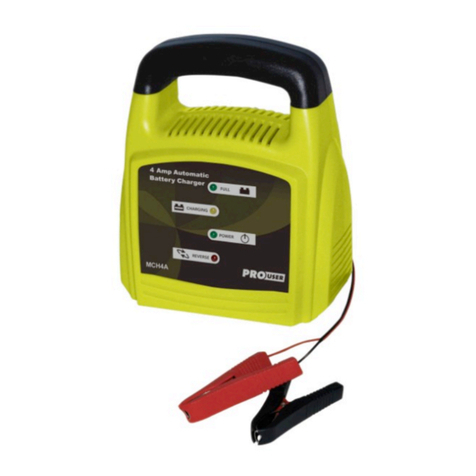
pro user
pro user MCH4A manual
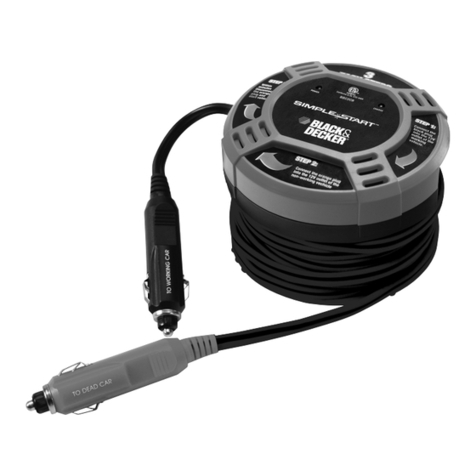
Black & Decker
Black & Decker SIMPLE START BBC2CB instruction manual
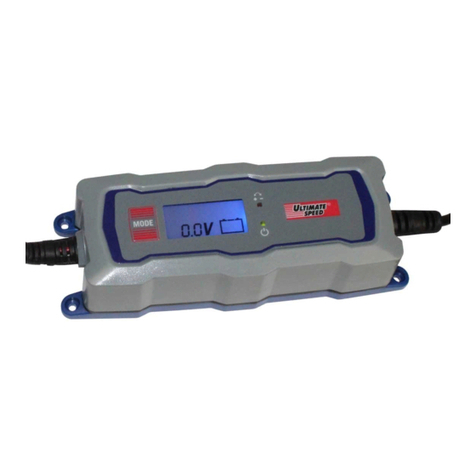
ULTIMATE SPEED
ULTIMATE SPEED ULGD 3.8 A1 Operation and safety notes

CRAIG & DERRICOTT
CRAIG & DERRICOTT SMART ION CHARGE EV03221000 Installation & maintenance
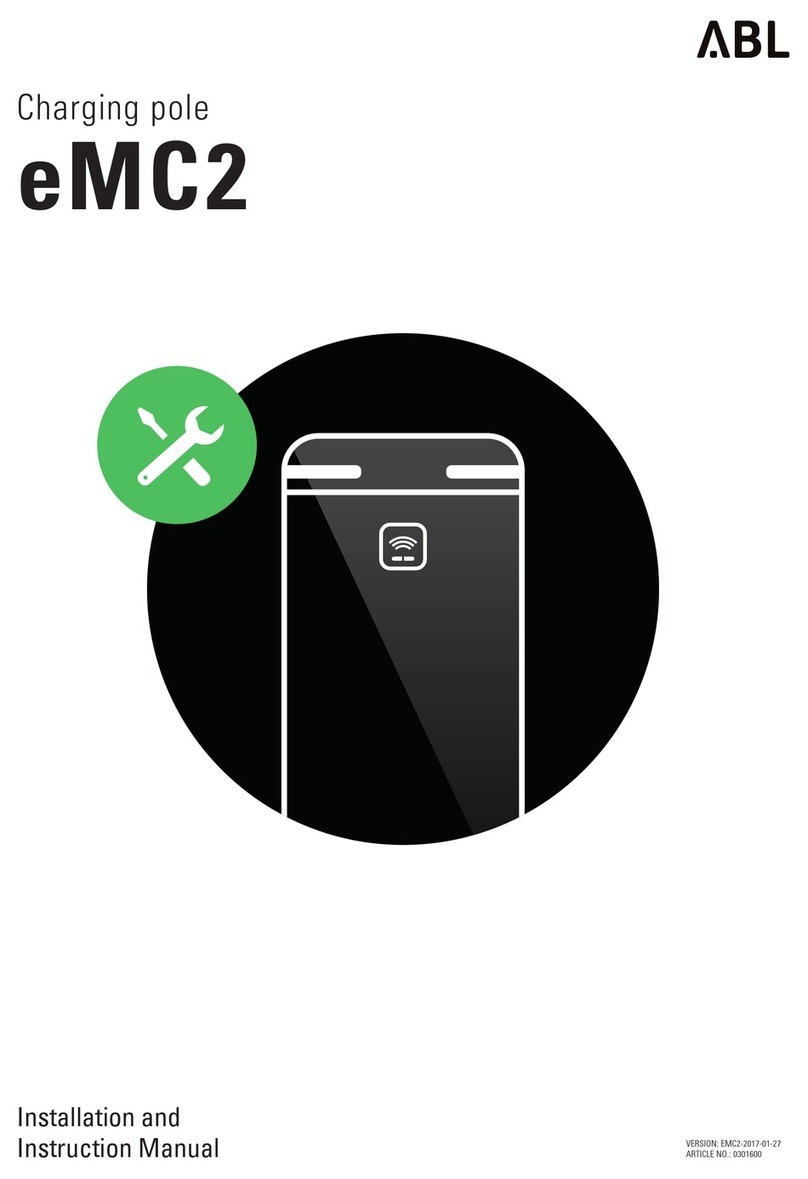
ABL
ABL eMC2 manual
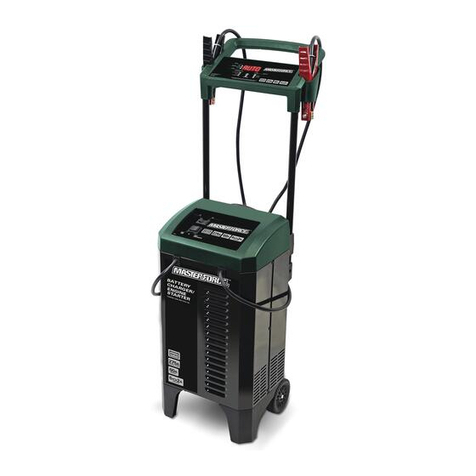
Menards
Menards MASTERFORCE 260-9514 Operator's manual

